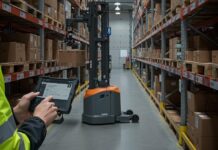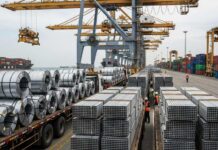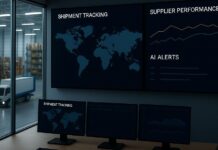In today’s interconnected global market, supply chain disruptions are an ever-present challenge, often arising unexpectedly and impacting industries worldwide. As the backbone of modern logistics, the supply chain must remain resilient to weather unforeseen obstacles that can affect everything from production and transportation to warehousing and final delivery. Managing these disruptions is particularly critical for third-party logistics (3PL) providers, who support diverse industries and manage complex fulfillment operations. The unpredictable nature of supply chain disruptions means that there is no one-size-fits-all solution, and 3PLs must adopt dynamic strategies to adapt and thrive.
This article explores what supply chain disruptions entail, the primary causes behind them, and strategies 3PL providers can employ to effectively navigate these challenges.
What Are Supply Chain Disruptions?
Supply chain disruptions are events that interfere with the normal flow of goods and services, halting or delaying processes such as production, warehousing, and transportation. These disruptions can occur at any point in the supply chain, from sourcing raw materials to final delivery. Depending on their origin, disruptions can have varying degrees of impact: they may be local, regional, or even global. For example, severe weather events in the English Channel can affect global maritime shipping routes, while labor strikes at a single port can impact supply chain operations along an entire coast.
The ripple effects of these disruptions highlight the importance of a resilient and adaptable supply chain, especially for 3PL providers who handle logistics for multiple clients and rely on a seamless flow of goods to meet service expectations.
Causes of Supply Chain Disruptions
Supply chain disruptions stem from a range of factors, which can vary widely depending on location and industry. The most common causes include:
1. Macroeconomic Factors
The global supply chain is highly interconnected, which makes it susceptible to economic disruptions. Events like inflation, trade conflicts, and geopolitical tensions can destabilize global trade and lead to widespread supply chain issues. For instance, trade sanctions between countries or volatile tariffs can alter trade routes, leading to sudden shifts in supply and demand balances. These macroeconomic changes create challenges for global trade, often making it difficult for supply chains to operate efficiently.
2. Labor and Resource Shortages
Labor shortages have increasingly affected supply chains, as skilled workers are essential for logistics operations. According to recent reports, over half of supply chain executives have cited challenges in hiring and retaining qualified workers. Labor shortages slow down operations, resulting in delayed shipments and missed deliveries. Additionally, strikes or industrial actions can amplify these delays, further complicating logistics.
3. Technological Failures and Cyber Threats
Technology is fundamental to today’s supply chain operations, supporting everything from inventory tracking to order fulfillment. However, technological failures or cyber threats can lead to severe disruptions. In a tech-driven supply chain, issues such as system outages or hacking incidents can compromise data security and halt logistics processes. Cybersecurity is crucial for maintaining an uninterrupted supply chain, especially in industries that depend on real-time data and digital communication.
How 3PLs Manage Supply Chain Disruptions
Third-party logistics providers are essential players in the e-commerce and retail industries, overseeing end-to-end fulfillment services from sourcing to last-mile delivery. Because of their central role in supply chain operations, 3PLs are well-positioned to tackle and mitigate the effects of supply chain disruptions. Here are some key approaches they use:
1. Flexible Warehousing and Logistics Solutions
Given the unpredictable nature of supply chain disruptions, 3PLs offer flexible warehousing solutions to help their clients scale inventory according to demand fluctuations. Flexible warehousing enables companies to adjust stock levels, mitigating the risks of overstocking or understocking. This adaptability is crucial for handling demand shifts, especially during unexpected events that disrupt the regular flow of goods.
2. Transportation Diversification
Relying on a single mode of transportation can leave a 3PL vulnerable to delays caused by specific bottlenecks, such as road congestion or port blockages. Diversified transportation options—such as rail, road, ocean, and air—give 3PLs more flexibility to reroute shipments if one route encounters disruptions. This approach minimizes the risk of extended delays, helping 3PLs maintain delivery schedules despite unexpected transportation issues.
3. Proactive Risk Management and Planning
Proactive planning and risk management are essential for anticipating and mitigating supply chain disruptions. By using advanced technologies like AI-driven forecasting and predictive analytics, 3PLs can gain insights into potential disruptions before they occur. AI-powered systems can optimize routes, identify backup options, and help 3PLs make data-driven decisions. This proactive approach reduces the likelihood of costly delays and equips logistics providers with contingency strategies.
Strategies for 3PLs to Navigate Supply Chain Disruptions
To effectively manage supply chain disruptions, 3PLs can implement a range of strategies, such as:
1. Diversifying Suppliers and Sourcing Regions
Relying on a single supplier or sourcing region can increase vulnerability to disruptions. By diversifying suppliers and sourcing regions, 3PLs reduce the risk of an entire supply chain halting if one supplier faces issues. This diversification ensures that even if a disruption affects one area, alternative suppliers can meet demand and minimize operational setbacks.
2. Building Strategic Stockpiles
Maintaining a buffer inventory, or strategic stockpile, helps 3PLs continue fulfilling orders during supply chain disruptions. With calculated safety stock levels, 3PLs can restock items promptly when a disruption threatens supply. This approach ensures that clients experience minimal interruptions, even when facing shortages or delays in receiving new stock.
3. Adopting Multi-Carrier and Rate-Shopping Strategies
Utilizing multiple carriers allows 3PLs to choose between shipping providers, reducing the impact of disruptions. In times of delay or rate hikes with one carrier, 3PLs can switch to an alternative, maintaining service continuity. Rate-shopping technology further helps 3PLs secure competitive pricing and avoid reliance on a single provider, keeping logistics costs predictable and manageable.
4. Integrating Technology for Visibility and Forecasting
Complete supply chain visibility is essential for anticipating and reacting to disruptions. With real-time tracking and predictive analytics, 3PLs gain visibility into each step of the supply chain. Technologies like IoT sensors and AI-based forecasting tools provide 3PLs with data on inventory levels, transit times, and potential delays, enabling them to make quick decisions and implement alternative strategies when disruptions arise.
5. Building Agility and Resilience
Flexibility and resilience are fundamental to navigating supply chain disruptions. By leveraging advanced fulfillment management systems, 3PLs can enhance operational agility and respond to disruptions more effectively. These systems help 3PLs manage fluctuating volumes, adjust to demand shifts, and quickly deploy resources where needed. Investing in resilience enables 3PLs to maintain service quality even during challenging periods.
Why Building Resilience Matters
For 3PLs, building a resilient supply chain means being prepared for both expected and unexpected challenges. A resilient 3PL can maintain fulfillment standards and meet client expectations, even when facing disruptions. Resilience not only minimizes the operational and financial impacts of disruptions but also strengthens customer relationships, as clients rely on consistent service quality to meet their own business goals.
Final Thoughts on Navigating Supply Chain Disruptions
In the face of unpredictable supply chain disruptions, 3PLs play a critical role in keeping logistics operations running smoothly. From diversified transportation and flexible warehousing to advanced technology and proactive planning, 3PLs deploy a range of strategies to navigate challenges and ensure business continuity. By adopting these practices, 3PLs provide reliable solutions for businesses looking to stabilize their supply chains and meet customer demand, regardless of external disruptions.
For companies considering outsourcing logistics, understanding a 3PL’s capacity to manage supply chain disruptions is essential. A reliable 3PL with a resilient approach can be a valuable partner, offering stability, flexibility, and expertise in times of uncertainty. As the global logistics landscape continues to evolve, the ability to manage and mitigate disruptions will remain a top priority, positioning 3PLs as key players in supporting uninterrupted supply chains and meeting the demands of a complex, interconnected world.
































